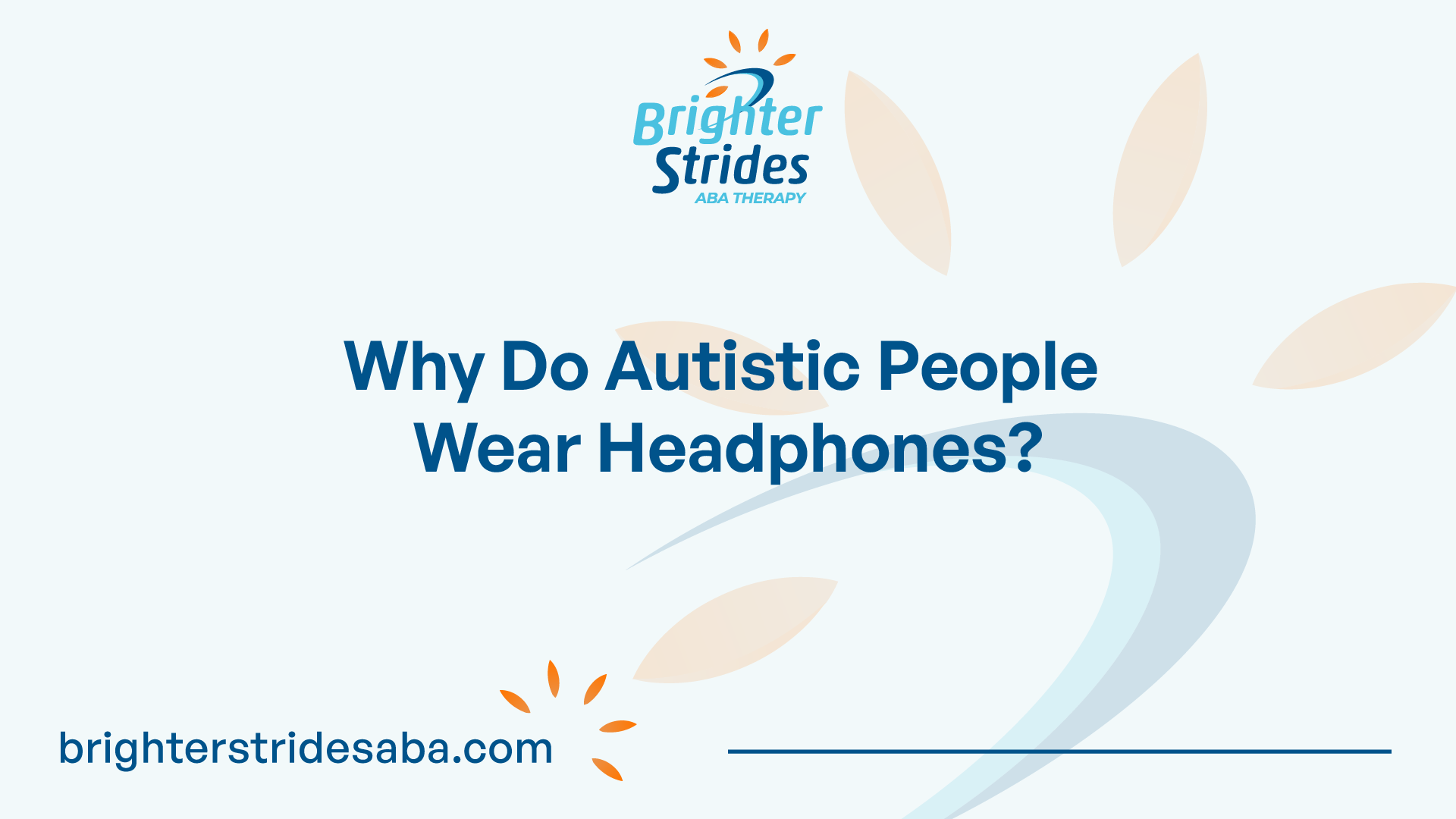Sensory Sensitivities in Autism
One of the aspects of understanding why autistic people wear headphones is recognizing the sensory sensitivities that are often associated with autism. Sensory differences can significantly impact an autistic person’s experience of the world, often leading to high levels of anxiety and emotional distress.

Understanding Sensory Differences
Autistic people may experience difficulties interpreting and organizing input from their senses – what they see, taste, touch, hear, and smell. These sensory differences are a common part of the autistic experience and can vary greatly from person to person [1].
According to Autism Tasmania, people with autism can be either hypersensitive (over-reactive) or hyposensitive (under-reactive) to sensory input. They may also experience fragmented or distorted perceptions. These variations impact their responses to sensory experiences, which can fluctuate daily.
| Sensory Sensitivity | Description |
|---|---|
| Hypersensitivity | Over-reactive to sensory input, may find certain sounds, smells, or textures overwhelming |
| Hyposensitivity | Under-reactive to sensory input, may have a high pain threshold or not react to temperatures |
Impact of Sensory Sensitivities
The impact of these sensory sensitivities on autistic people can be significant. Hypersensitive individuals may find the world overwhelming, with seemingly ordinary stimuli causing distress or discomfort. These individuals may avoid certain situations due to their sensory sensitivities.
Conversely, hyposensitive individuals may seek out certain sensory experiences or stimuli. They may not feel pain or temperature in the same way as others, leading to potential risks or difficulties in daily life.
Importantly, these sensory sensitivities can lead to stimming behaviors, which are common among individuals with autism. Stimming, which often involves repetitive movements or sounds, can help regulate the sensory environment. It can be calming for hypersensitive individuals, potentially reducing sensory overload, while also increasing stimulation and focus for those hypo-sensitive to sensory input.
Understanding these sensory sensitivities and their impacts is a crucial first step in unravelling the reasons why many autistic people often wear headphones. This knowledge helps to provide context for the strategies and interventions that are often beneficial for autistic individuals.
Stimming and Regulation
Stimming and regulation play crucial roles in managing sensory sensitivities often observed in autistic individuals. To understand why autistic people wear headphones, it is first necessary to comprehend the role of stimming in sensory regulation.
Role of Stimming
Autistic individuals often engage in stimming behaviors as a way to regulate their sensory environment. According to Autism Tasmania, stimming can be calming for those who are hypersensitive to sensory input and can help reduce sensory overload. On the other hand, it can also increase stimulation and focus for those who are hypo-sensitive to sensory input.
Stimming behaviors are a common coping mechanism among individuals with autism and serve to regulate sensory input. They can help individuals with hypersensitivity to sensory stimuli to calm down and reduce anxiety, while also providing increased stimulation and focus for those with hyposensitivity.
Regulation Strategies
Regulation strategies help autistic individuals to self-regulate and manage their sensory needs. Stimming is one such strategy that allows them to cope with overwhelming sensory input and maintain a sense of control and comfort.
For those who are hypersensitive, stimming can be calming and help reduce sensory overload. For those who are hyposensitive, stimming can increase stimulation and focus.
Stimming is a natural and important way for autistic individuals to regulate their sensory environment. It can help them cope with sensory sensitivities and maintain a sense of control and comfort [5].
In summary, stimming and regulation strategies, such as using headphones, play a critical role in helping autistic individuals manage their sensory sensitivities. These strategies provide a means for these individuals to control their sensory input, thereby enhancing their comfort and ability to engage with the world around them.
Why Autistic Individuals Wear Headphones
In the conversation about autism, understanding sensory sensitivities is essential. A common question that arises is: why do autistic people wear headphones? This practice is closely linked to the coping mechanisms employed by individuals with autism to manage sensory overload and create a sense of auditory control.
Coping with Sensory Overload
Sensory overload is a common experience among individuals with autism. It occurs when the brain struggles to process an overwhelming amount of sensory information from the environment, leading to intense and distressing responses. Some common responses to sensory overload include anxiety, agitation, and discomfort.
The specific effects of sensory overload can vary from person to person but can disrupt the ability of individuals with autism to focus, communicate, and engage in daily activities. Wearing headphones is a valuable coping mechanism for individuals with autism, as it can help manage their surroundings more effectively and reduce the impact of sensory overload.
Creating Auditory Control
Creating a sense of auditory control is a crucial aspect of why autistic individuals often wear headphones. These devices provide a barrier against noise and help create a more controlled and predictable auditory environment.
Autistic individuals may wear headphones as a way to regulate their sensory input and minimize the impact of overwhelming sounds in their environment. Wearing headphones can create a personal auditory space that helps reduce the impact of external sounds and provide a sense of control and comfort.
The type of headphones used can vary based on personal preference. Some individuals may choose noise-canceling headphones, while others may prefer ear defenders or other types of headphones that provide a physical barrier to sound [6].
In conclusion, the use of headphones amongst autistic individuals serves as a practical and effective tool to manage sensory overload and establish a sense of auditory control. Recognizing this, along with other coping mechanisms, is vital in supporting the needs of individuals with autism.
Benefits of Headphone Usage
Understanding why autistic people wear headphones is essential to creating a more inclusive and accommodating environment. Headphones bring numerous benefits for individuals on the autism spectrum, particularly in managing sound sensitivity and creating a sensory sanctuary.
Managing Sound Sensitivity
One of the primary reasons autistic individuals may wear headphones is to regulate their sensory input and minimize the impact of overwhelming sounds in their environment. Sensory overload is a common experience among individuals with autism, occurring when there is an excess of sensory information from the environment that the brain struggles to process. This can lead to intense and distressing responses, including anxiety, agitation, and discomfort.
Wearing headphones can serve as a valuable coping mechanism, helping individuals navigate their surroundings more effectively and reduce sensory overload. Some individuals may choose noise-canceling headphones, which actively block out external sounds, while others may prefer ear defenders or other types of headphones that provide a physical barrier to sound. The choice of headphones largely depends on the individual’s specific sensory needs and preferences.
Providing Sensory Sanctuary
Beyond managing sound sensitivity, headphones can create a personal auditory space that helps reduce the impact of external sounds, providing a sense of control and comfort. This can be particularly beneficial in busy or noisy environments, where the volume and variety of sounds can be overwhelming.
By creating a sensory sanctuary, headphones can help individuals with autism focus, communicate, and engage in daily activities more effectively. They can also foster a sense of security and predictability, allowing individuals to better manage their sensory experiences and navigate the world around them.
Embracing and supporting the use of headphones is a vital part of promoting inclusivity for individuals on the autism spectrum. By understanding their role and benefits, we can contribute to creating environments that respect and accommodate the sensory needs of autistic individuals [8].
Support Strategies
Aiding autistic individuals in their day-to-day lives often involves a combination of understanding their individual needs and creating supportive environments. One aspect that often arises in discussions around autism is the question, “why do autistic people wear headphones?” The answer lies in their unique sensory needs and how headphones can provide a measure of control and comfort.
Creating Sensory-Friendly Environments
Sensory-friendly environments can significantly improve the quality of life for autistic individuals. This is particularly true for those who experience sensory sensitivities, as these environments can provide a much-needed respite from sensory overload.
Creating a sensory-friendly environment involves considering the sensory needs of the individual and modifying the environment accordingly. For example, autistic individuals may benefit from having quiet spaces to retreat to when they feel overstimulated.
Such spaces could include the use of noise-canceling headphones, which can create a quieter environment to manage sensory input. This can help to reduce stress and anxiety, providing opportunities for autistic individuals to withdraw and regroup throughout the day.
In addition to creating quiet spaces, having an organized home with designated spaces for specific activities can foster a sense of predictability and independence. Knowing where things are or where they go can reduce anxiety and foster independence [9].
Visual supports can also play a significant role in creating a sensory-friendly environment. Visual schedules, for instance, can provide predictability and lower anxiety by showing autistic individuals what comes next or what to do. This supports transitions and reduces stress, making them vital tools in creating a supportive, structured environment.
Understanding Autistic Needs
Understanding the unique needs of autistic individuals is crucial in providing effective support. Autistic individuals benefit highly from regulated and predictable schedules, and may need help to overcome anxiety around transitions and changes.
One way to do this is by finding areas of predictability within these transitions, which can aid in supporting communication. For example, if an autistic individual wears headphones as a way to manage sensory input, it’s important to understand this need and support it.
In essence, understanding the reasons behind why autistic individuals wear headphones and other sensory management strategies is crucial. It allows for the creation of supportive strategies that respect their needs and foster their independence, whilst also reducing their stress and anxiety.
Interventions for Sensory Needs
As part of understanding ‘why do autistic people wear headphones?’, it’s also important to look at other sensory needs and interventions that can support autistic individuals.
Promoting Mask-Wearing
In the context of current global health circumstances, promoting mask-wearing among autistic individuals has gained significant attention. Based on a review, behavior-analytic procedures have increased face mask-wearing in autistic individuals. Positive outcomes were observed in all seven studies included in the review, with an average effect size of 0.92 for non-overlap of all pairs (NAP) and 0.47 for Baseline Corrected Tau (BCT). The most common and effective procedures for increasing mask-wearing were graded exposure and differential and positive reinforcement [10].
| Intervention Type | Average Effect Size (NAP) | Average Effect Size (BCT) |
|---|---|---|
| Graded Exposure | 0.92 | 0.47 |
| Differential Reinforcement | 0.92 | 0.47 |
Effective Intervention Components
Certain intervention components have been identified as the most effective in increasing mask-wearing in autistic individuals. These include exposure hierarchies and differential and contingent reinforcement, which were used in four of the seven studies included in the review.
The use of telehealth did not impact the effectiveness of behavior-analytic interventions. Studies that used telehealth as a mode of intervention delivery had similar outcomes to those that were conducted in person.
Furthermore, interventions implemented by natural agents, such as parents or regular ABA therapists, were as effective as those implemented by study experimenters. There were no differences in treatment fidelity based on who implemented the procedures [10].
The social validity of these procedures was generally rated as acceptable by both parents and professionals. Acceptability and satisfaction with the outcomes of the interventions were reported in five of the studies included in the review [10].
Understanding these interventions and their effectiveness can help caregivers and professionals provide the necessary support for autistic individuals facing sensory challenges, be it auditory sensitivities or the need to wear a mask.
References
[1]: https://www.autismtas.org.au/about-autism/key-areas-of-difference/sensory-differences/
[3]: http://autismawarenesscentre.com/
[4]: http://yellowbusaba.com/
[6]: https://www.goldstarrehab.com/parent-resources/why-do-autistic-people-wear-headphones
[7]: https://www.abtaba.com/blog/autistic-people-wear-headphones/
[8]: https://www.yellowbusaba.com/post/why-do-autistic-people-wear-headphones
[9]: https://autismawarenesscentre.com/what-is-a-structured-environment-why-is-it-helpful-for-autistic-individuals/
[10]: https://link.springer.com/article/10.1007/s10803-023-06128-x

 We've just released an article!
Check out our blog!
We've just released an article!
Check out our blog!



